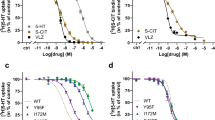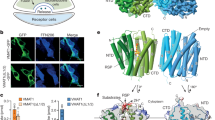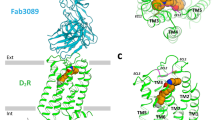Abstract
IMIPRAMINE was first shown1 in 1958 to be effective in the treatment of endogenous depression. It is one of the most widely prescribed members of the tricyclic antidepressant group of compounds which have been chosen for the treatment of the average depressed patient2. It is perhaps snuprising that not a single member of this important group of psychotropic drugs has been investigated by X-ray analysis. There is now considerable evidence that a functional abnormality of one or more of the biogenic amine systems of the brain is involved in the aetiology of the depressive or affective disorders3. Amines which have been investigated most thoroughly in this respect are noradrenaline4 and 5-hydroxy-tryptamine5 (5-HT). The synaptic action of these putative neurotransmitters is thought to be terminated largely by an active uptake back into the presynaptic nerve ending, and the rat brain is known to possess separate neuronal uptake systems for noradrenaline6 and 5-HT7. The most striking neurochemical effect of tricyclic antidepressants is their potency in inhibiting these transport processes8, and indeed it has been suggested that this effect may be responsible for their clinical ameliorative action4. Structure-activity relationships for various imipramine analogues as inhibitors of noradrenaline9 and 5-HT10,11 uptake have been reported and recently a possible molecular mechanism for this inhibitory effect has been proposed12. In an attempt, therefore, to gain some insight into the conformational requirements for a compound to be a potent inhibitor of noradrenaline and 5-HT uptake, we are investigating the X-ray structures of a number of tricyclic antidepressants13; that of imipramine is reported here.
This is a preview of subscription content, access via your institution
Access options
Subscribe to this journal
Receive 51 print issues and online access
$199.00 per year
only $3.90 per issue
Buy this article
- Purchase on Springer Link
- Instant access to full article PDF
Prices may be subject to local taxes which are calculated during checkout
Similar content being viewed by others
References
Kuhn, R., Am. J. Psychiat., 115, 459–464 (1958).
Klein, D. F., and Davis, J. M., Diagnosis and Drug Treatment of Psychiatric Disorders (Williams and Wilkins, Baltimore, 1969).
Ashcroft, G. W., Eccleston, D., Murray, L. G., Glen, A. I. M., Crawford, T. B.B., Pullar, I. A., Shields, P. J., Walter, D. S., Blackburn, I. M., Connechan, J., and Lonergan, M., Lancet, ii, 573–577 (1972).
Schildkraut, J. J., and Kety, S. S., Science, 156, 21–30 (1967).
Coppen, A., J. Psychiat. Res., 9, 163–171 (1972).
Horn, A. S., Br. J. Pharmac., 47, 332–338 (1973).
Shaskan, E. G., and Snyder, S. H., J. Pharmac. exp. Ther., 175, 404–418 (1970).
Iversen, L. L., Br. J. Pharmac., 41, 571–591 (1971).
Horn, A. S., Coyle, J. T., and Snyder, S. H., Molec. Pharm., 7, 66–80 (1971).
Horn, A. S., and Trace, R. C. A. M., Br. J. Pharmac., 51, 399–403 (1974).
Todrick, A., Tate, A. C., J. Pharm. Pharmac., 21, 751–762 (1969).
Horn, A. S., Biochem. Pharmac., suppl. (part 1) April, 320–322 (1974); in Frontiers in Catecholamine Research (edit. by Usdin, E., and Snyder, S.), 411–413 (Pergamon, 1973).
Rodgers, J. R., Kennard, O., Horn, A. S., and Riva Di Sanseverino, L., Acta. Cryst., B 30, 1970–1974 (1974).
Maxwell, R. A., Keenan, P. D., Chaplin, E., Roth, B., and Batmanglidj Eckhardt, S., J. Pharmac. exp. Ther., 166, 320–329 (1969).
Tuomisto, J., J. Pharm. Pharmac., 26, 92–100 (1973).
Horn, A. S., and Snyder, S. H., J. Pharmac. exp. Ther., 180, 523–530 (1972).
Miller, D. D., Fowble, J., and Patil, P. N., J. med. Chem., 16, 177–178 (1973).
Horn, A. S., J. Pharm. Pharmac., 26, 735–737 (1974).
Carlstrom, D., and Bergin, R., Acta Cryst., 23, 313–319 (1967).
Ison, R. R., Partington, P., and Roberts, G. C. K., Molec. Pharm., 9, 756–765 (1973).
Kier, L. B., J. Pharm. Pharmac., 21, 93–96 (1969).
Abraham, R. J., Kricka, L. J., and Ledwith, A., J. Chem. Soc. (in the press).
Motherwell, W. D. S., and Isaacs, N. W., J. molec. Biol., 71, 231–241 (1972).
Author information
Authors and Affiliations
Rights and permissions
About this article
Cite this article
POST, M., KENNARD, O. & HORN, A. Possible pharmacological and theoretical implications of X-ray structure of the tricyclic antidepressant imipramine. Nature 252, 493–495 (1974). https://doi.org/10.1038/252493a0
Received:
Accepted:
Issue Date:
DOI: https://doi.org/10.1038/252493a0
This article is cited by
-
Conformation of dibenzo[b,f]heteroepin drugs and related compounds
Journal of Crystallographic and Spectroscopic Research (1984)
-
Synthesis and some pharmacological properties of a conformationally restricted imipramine analogue
Pharmaceutisch Weekblad (1983)
Comments
By submitting a comment you agree to abide by our Terms and Community Guidelines. If you find something abusive or that does not comply with our terms or guidelines please flag it as inappropriate.



